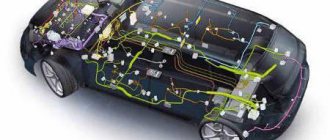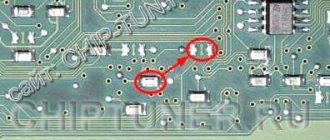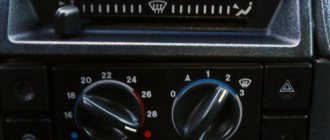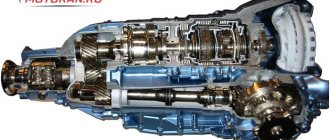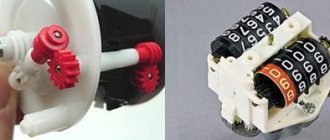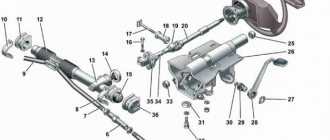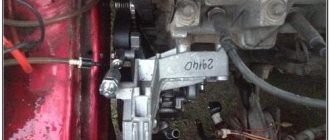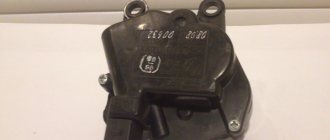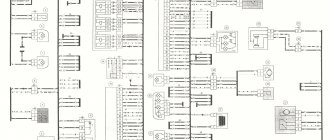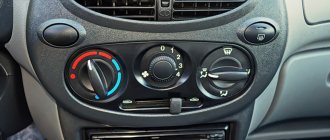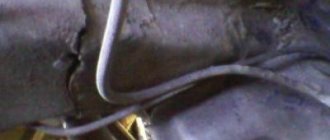After the active introduction of an injection power system on various VAZ models, the overall design of the car became more complex. As you know, an injector, unlike a carburetor, cannot dose fuel itself. To solve the problem, control of the fuel injectors was transferred to the electronic engine control unit (ECU) or controller, better known as a computer or “brains”.
On the one hand, by installing the brains in the VAZ, the manufacturer made the engine more economical and less toxic. However, on the other hand, the control system has become more complex, and a large number of additional solutions and devices have appeared. Next, we will look at what features the VAZ electronic unit has, where it is located on different models, what functions the ECU performs, etc.
VAZ injection models: ECU, controller purpose and features
So, the injector, which is actually represented by electronic-mechanical injectors, cannot dose fuel on its own. The engine control unit is responsible for the correct operation of the injectors. In turn, this unit is actually the electronic engine control system (ECM).
This system is based on a group of sensors that send their signals to the ECU, then the unit processes the information and then generates control signals to the actuators. The main task is to make the engine operate in optimal mode and maintain optimal operating parameters of the internal combustion engine, taking into account constantly changing conditions.
So, the ECU receives signals from a large number of sensors, after which, using algorithms “hardwired” into the unit’s memory, the amount of fuel required for the engine to operate in optimal mode is calculated. The ECU also controls the moment of spark formation in the cylinders, replacing the ignition system on a car with a carburetor.
The ECU also conducts self-diagnosis and checks the condition of the engine, recording failures, deviations and irregularities in operation. If the controller cannot correct the situation, then an error is recorded in the memory, and the driver receives a notification in the form of a “check” icon on the instrument panel.
- As for the sensors, thanks to their presence, the ECU determines the engine operating mode, speed, and load on the internal combustion engine. For example, the MAF (mass air flow sensor) allows you to obtain data to calculate the amount of fuel, taking into account the amount of air entering the cylinders.
(the temperature sensor determines the temperature of the internal combustion engine, thereby indicating how the fuel will burn in a cold and warm engine). TPS (throttle position sensor) shows how hard the gas pedal is pressed.
Also, the crankshaft sensor (CPCV) and the camshaft sensor (CPR) allow the computer to determine the time of fuel injection into the cylinders, the time of creation of a spark on the spark plugs in each individual cylinder, etc. In fact, it turns out that later versions of the ECU are able to calculate the amount of fuel for each individual cylinder in order to obtain stable and efficient engine operation, as well as control the ignition.
If fuel combustion becomes explosive, the explosion is detected by the engine knock sensor (). The control unit adjusts the mixture and changes the ignition angle to avoid detonation. If the ECU cannot solve the problem, the “check” lights up and the error is recorded in the ECU’s memory.
Even on later VAZ models, the VAZ controllers and firmware themselves changed, since oxygen sensors paired with a catalyst were used in the design. These sensors determine the efficiency of fuel combustion by recording the amount of oxygen in the exhaust. So, for this reason, you need to take into account that ECUs of different generations are different.
For example, older versions did not have support for a phase sensor (DPRV); injection took place into the intake manifold, and not into each cylinder individually. These ECUs are the central injection control unit. Later, blocks appeared that prepared the mixture for each individual cylinder (distributed injection ECU).
Subsequently, support for an oxygen sensor was implemented, then two oxygen sensors (taking into account stricter toxicity standards) for more efficient use of the catalytic converter.
In any case, when selecting an ECU for a car, you need to know exactly a number of features: block and firmware version, ECU pinout, etc. To put it simply, the brains of a VAZ 2114 may differ from the ECU of a VAZ 2115, and the control unit of a VAZ 2110 will not work on a VAZ 2108 injector.
This means that Kalin’s brains cannot be used as a replacement for the Priora ECU, although one and the other unit will be VAZ ECUs. It turns out that it is important to know which unit is installed on a particular car. To determine this, you need to understand where the VAZ ECU is located, and then study the markings on the device. Let's figure it out.
"January-4" and GM-09
If the ECU is marked 2114-141020-22, then this is a “January-4” model. If the last characters are 10, 20, 20, 21, then the car owner is dealing with a GM-09 control unit. These are the very first versions of the ECU for these cars. The vehicles were equipped with these units until 2003. They differ from each other in some sensors for the EURO-2 standard. On the market, such “brains” can be bought for up to six thousand rubles.
Where is the VAZ ECU located and the interchangeability of control units
First of all, to determine the type of control unit, you need to find its installation location in the car. To do this, you should study the manual. As an example, let's look at the VAZ 2108 - 2115. On these cars, the ECU is located in the passenger compartment, on the front right, slightly below the glove compartment.
By the way, this information is also useful for computer diagnostics, since you need to know where you can connect to the diagnostic connector installed in various places on a particular model.
Diagnostic connectors VAZ 2108 - 21099 with a low panel are located near the ECU, under the glove compartment. Models VAZ 2108 - 21099 with a high panel, as well as 2113 - 2115, have a connector inside the center console. The VAZ 2108 - 2115 version with the so-called Europanel has a connector on the panel, and it is located closer to the passenger door.
- As for the units themselves, VAZ 2108 - 2115 of different years of production have different ECU models. For example, the most popular ECU January 4 was installed on early models of injection engines with central injection into the intake manifold.
Version January 5 - 6 are ECUs with distributed injection, but without oxygen sensor support. The January 7 control unit has appeared on cars since 2007, supports all sensors, and effectively controls the engine.
Let us also add that in addition to January, different generations of GM units were actively used at VAZ, being an analogy of January 4 - 7. The same can be said about Bosch or Itelma ECUs. Taking into account all the features, interchangeability is possible, but you need to select analogues that are suitable for the class, version, number of supported sensors, etc.
The fact is that each model is only suitable for a certain combination of engine and sensors, as well as wiring and firmware. This means that different models, even within the same family, can only be installed taking into account full compatibility.
Let us note once again that the types of ECUs on VAZs differ. It turns out that you cannot put January 5.1 instead of January - 4 or GM-09 SAMARA, however, for January 5.1 there is interchangeability with VS (Itelma) 5.1 or Bosch M1.5.4. In turn, the Bosch M7.9.7 ECU is not compatible with previous units, but can be replaced with January 7.2 Itelma or Avtel.
To accurately identify the ECU, just remove the instrument panel frame from the side and write down the ECU number. Also, if you have a BC, you can optionally view the version and type of the ECU, as well as the firmware number of the unit
Types of ECU
VAZ-2114 is a car that is already quite old. But time was not in vain for the model. Engineers and electronics specialists constantly worked to improve their brainchild. This also applies to the control unit. A total of eight generations of ECUs were produced. They differed not only in their technical characteristics, but also in their manufacturer.
The owner may be wondering what kind of “brains” are on the VAZ-2114. To find out, just visually look at the block body. There is a marking on it. It contains the ECU model number. It is enough to compare what is written on the block with the factory tables. Then it will become clear what is installed in the car.
Frequent malfunctions of the VAZ electronic control unit
Considering that the controller is a complex electronic device, failure of the ECU cannot be ruled out. As a rule, the causes of ECU malfunction can be different, ranging from mechanical damage to software failures.
For example, a common cause of breakdowns is overheating or liquid ingress. As practice shows, on the Lada Samara the ECU is located near the heater radiator. It is not difficult to guess that a radiator leak and coolant entering the controller often disables this device.
We also recommend reading the article about what the ELM327 diagnostic adapter is. From this article you will learn about the purpose, functionality, and features of selecting the ELM327 scanner.
Also, voltage surges in the on-board network lead to the fact that individual parts in the control unit burn out, and the memory bank with firmware suffers. For example, this happens if the battery terminals come loose. Also, poor contact with the spark plugs or high resistance of the explosive wires form an electromotive force in the primary winding of the ignition coil. The result is a breakdown of the output transistors of the control unit.
In this case, the check engine light does not always light up on the panel, but the engine malfunctions. In such a situation, when no other causes have been identified, what is needed is not diagnostics of the engine and systems, but professional diagnostics of the car's ECU, which can only be performed by an experienced specialist. Often, after checking, the unit may need to be replaced, since ECU repair is often not recommended.
Bosch M1.5.4, “Itelma 5.1”, “January 5.1”
If the car has Bosch firmware installed, then the following symbols can be seen on the body - 21114-1411020. If the numbers are 2114-1411020-70, 71, then this is Itelma. If the last digit is 72, then it is "January 5.1". These are second-generation units, representing more universal solutions that are found on the VAZ-2113 and 2115.
As for the principle of functioning of the “brains” of the VAZ-2114 with 8 valves, the ECU is completely identical. These units were installed on cars even after 2013, as the device turned out to be very successful. After 2013, the January 5.1 modification began to be produced in three versions. The main differences were in injection control. ECUs from Itelma and January 5.1 can be purchased today at prices starting from eight thousand rubles. Bosch ECUs were installed mainly on export cars, but they are offered at about the same price.
Let's sum it up
As you can see, by analogy with various foreign cars, VAZ injection engines of different generations are also equipped with controllers of various types. Early versions have simple solutions that are responsible for simple mixture formation and work with a small number of sensors.
We also recommend reading the article about how the automatic transmission ECU works. From this article you will learn about the features, principles of operation, purpose and breakdowns of the electronic control unit of the automatic transmission.
At the same time, more modern control units are distinguished by support for distributed injection, more flexible control of the ignition system, as well as the ability to interact with oxygen sensors, etc.
For this reason, if it is necessary to replace a VAZ ECU, it is necessary to carefully approach the selection of the control unit for replacement. Moreover, even if the blocks are compatible in terms of version, type and connectors, the firmware version must also be taken into account.
Only after all the nuances have been taken into account can you expect that the engine under ECU control will operate correctly and without failures, and the owner himself will receive stable operation of the power unit and systems, environmental friendliness and maximum efficiency from the engine in different operating modes of the car’s engine.
ECU memory structure
The “brains” of the VAZ-2114 are characterized by a three-stage memory system. Each cascade is distinguished by the presence of separate working modules. Let's look at them in detail:
- RAM cascade is a familiar word for those who understand the design and operating principle of a PC. The functions of RAM (random access memory) in this case are also nothing new. The above cascade is a block of ordinary RAM where current work sessions are processed.
- The PROM block (programmable read-only memory) is a long-term memory in the VAZ-2114 ECU. The system contains data about when the driver needs to undergo maintenance. Fuel maps, previous calibrations, and control algorithms are also stored here. Also, in this block of “brains” of the VAZ-2114, the main firmware is saved. The information contained in this cascade will never be erased. If we draw an analogy with a computer, it is a device for permanently storing data; it will never be removed from here. When re-flashing the “brains”, changes are made here.
- The next stage is EPROM (electrically reprogrammable memory). This is a separate module. Its main function is to monitor the operation of anti-theft systems. The section stores encodings, passwords, methods and features of synchronizing information between the EEPROM and the immobilizer in the car. If suddenly for some reason the data packets do not match, the car engine will not start.
Each module is a separate block. The connections between them are made in the same way as on the computer motherboard.
Bosch M 7.9.7 and "January 7.2"
“January” was installed in a large number of models, depending on the engine size and type of equipment. For example, on a 1.5-liter eight-valve engine, ECUs from Avtel were installed, with 81 and 81 hour markings. The same “brains”, but from Itelma, were marked with 82 and 82 hour markings. "Bosch" was installed on export cars. The marking of such ECUs is as follows: 80 and 802 for EURO-2 and 30 for EURO-3 standard.
The 30th series of Bosch ECUs were also installed on 1.6-liter power units. Since the software was initially developed for volume 1.5, significant failures were observed or the system completely failed. Therefore, later they released a special package marked 31h.
Cars with a 1.6 engine manufactured for the domestic market were equipped with blocks from Avtel and Itelma. The first series from Avtel were marked 31. It was characterized by the same errors as the Bosch 30th series. Later the defects were eliminated in version 31h. Due to problems among competitors, car owners preferred blocks from Itelma. The successful series was released under the label 32.
The cost of a new block from these generations is now approximately eight thousand rubles. If you need a used unit, you can find it on the car market for up to four thousand rubles.
Description of "brains"
The VAZ 2114 ECU is an on-board computer of the vehicle, designed to control the main systems of the car. The parameters of the control module affect both the functionality of certain regulators and the operation of the engine as a whole. That is, the importance of this system cannot be denied.
Controller Location
In VAZ 2114 and VAZ 2115 cars, the control module is installed under the center console of the car, in particular, in the middle, behind the panel with the radio. To get to the controller, you need to unscrew the latches on the side frame of the console. As for the connection, in Samar modifications with a one and a half liter engine, the mass of the ECU is taken from the power unit housing, from the fastening of the plugs located to the right of the cylinder head.
Location of the ECU in the Chetyrka
In cars equipped with 1.6- and 1.5-liter engines with a new type of ECU, the mass is taken from the welded stud. The pin itself is fixed on the metal body of the control panel near the floor tunnel, not far from the ashtray. During production, VAZ engineers, as a rule, do not securely fix this pin, so over time it can become loose, which will lead to the inoperability of some devices.
Design and principle of operation
The control unit of the electronic system operates in accordance with the indicators received from the sensors:
- speed;
- detonation;
- lambda probe;
- fuel injection phases;
- crankshaft position;
- throttle position;
- air flow meter;
- antifreeze temperature.
In accordance with the data received from these controllers, the control module controls the following systems:
- ignition;
- adsorber;
- injectors, as well as a fuel pump;
- ventilation and heating system;
- programs for diagnosing vehicle performance;
- idle speed regulator (video author - Evgeniy Vekhter).
As for the device, the control module structurally consists of the following components:
- RAM or random access memory. This module contains basic data about recently identified errors detected by the electronic system in the operation of various components. When the driver turns off the ignition, the RAM unit is updated, causing this data to disappear.
- PROM is the main element of the system; it contains the firmware of the control module. It should be noted that this memory block contains all the necessary data on the calibration of the “four” systems along with the general engine control algorithm. Unlike RAM, EPROM is a permanent memory, so the data stored in it is retained even after the ignition is turned off. If necessary, this module can be reconfigured, that is, reprogrammed, which can lead to improved power as well as vehicle dynamics.
- ERPZU - the primary function of this module is to protect the car. The EEPROM memory contains information from the anti-theft installation - passwords, as well as encoding of the main parameters. Starting the engine will only be possible if the EEPROM successfully checks with the data contained in the immobilizer memory.
Typical malfunctions: their symptoms and causes
What are the signs that indicate a faulty ECU:
- there are no control signals coming from actuators (IAC, flow meter, various sensors, etc.);
- there is no signal for interaction with the ignition system, fuel pump, injectors and other elements;
- when connecting a diagnostic tester, there will also be no connection with the electronic system;
- Burnt contacts and mechanical damage to the device may also be a sign.
What reasons contribute to the failure of the control device:
- electrical circuit shorted or broken;
- improper electrical repairs, during which errors were made, in particular, we are talking about installing or repairing an anti-theft system;
- lighting a dead battery from a car with the engine running;
- a breakdown of the unit can be caused by incorrect connection of the battery terminals - plus instead of minus and vice versa;
- disconnecting the battery contacts when the engine is running;
- moisture on the electronic system module board;
- mechanical damage to the device as a result of an accident (the author of the video about repairing the control module in a garage is the Auto Practice channel).
